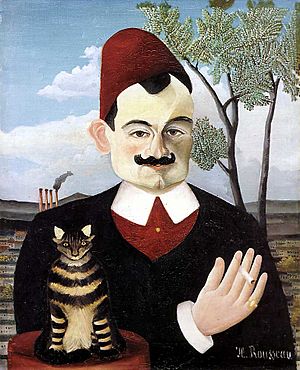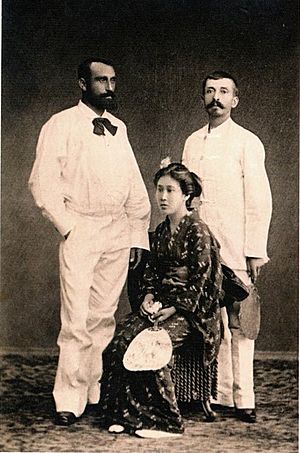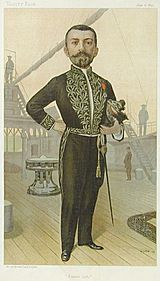Pierre Loti facts for kids
Quick facts for kids
Louis Marie-Julien Viaud
|
|
|---|---|

Pierre Loti on the day of his reception at the Académie Française, 7 April 1892
|
|
| Born | 14 January 1850 Rochefort, Charente-Maritime, France |
| Died | 10 June 1923 (aged 73) Hendaye, France |
| Pen name | Pierre Loti |
| Occupation | French navy officer, novelist |
| Nationality | French |
| Signature | |
 |
|
Pierre Loti (born Louis Marie-Julien Viaud; 14 January 1850 – 10 June 1923) was a famous French novelist and a naval officer. He was known for writing exciting stories set in faraway, exotic places. His books often shared his own travel experiences and feelings.
Contents
Pierre Loti's Life
Pierre Loti grew up in a Protestant family in Rochefort, Charente-Maritime, France. When he was 17, he joined the naval school in Brest. He studied at Le Borda and slowly moved up in his navy career. By 1906, he became a captain. He retired from active duty in 1910.
Loti often joked that he never read books. He even said this when he joined the famous Académie française in 1892. But his friends and his large library showed that he loved to read. In 1876, his fellow navy officers convinced him to turn his diary entries about his time in Istanbul into a novel. This book, called Aziyadé (1879), was published without his name. It was a mix of romance and his own life story.
Travels and Early Books
As part of his navy training, Loti traveled to the South Sea Islands. He lived in Papeete, Tahiti for two months in 1872. There, he "went native," meaning he lived like the local people. Years later, he wrote a book about his time there, first called Rarahu (1880). It was later reprinted as Le Mariage de Loti (The Marriage of Loti). This book made him famous. In the story, the local people gave him the name "Loti" because he mispronounced their word for a red flower, "roti." This book also inspired the 1883 opera Lakmé by Léo Delibes. A shallow pool at the Fautaua Falls in Tahiti is named Loti Bain, after him.
After this, he wrote Le Roman d'un spahi (1881). This book told the sad adventures of a soldier in Senegal. In 1882, Loti released a collection of four shorter pieces. These included three stories and a travel piece, all under the title Fleurs d'ennui (Flowers of Boredom).
Growing Fame and Important Works
In 1883, Pierre Loti became even more well-known. He published Mon Frère Yves (My Brother Yves). This novel described the life of a French naval officer, much like Loti himself, and a Breton sailor. A famous writer, Edmund Gosse, called it "one of his most characteristic productions."
While serving in Tonkin (now northern Vietnam) on the warship Atalante, Loti wrote three articles for the newspaper Le Figaro. These articles, published in 1883, described terrible events during the Battle of Thuận An. This was an attack by the French navy on Vietnamese defenses. Because of these articles, Loti was almost suspended from the navy. However, this made him even more famous with the public.
In 1886, Loti published Pêcheur d'Islande (An Iceland Fisherman). This novel was about the lives of fisherfolk from Brittany. Edmund Gosse called it "the most popular and finest of all his writings." The book used writing styles similar to the Impressionist painters of the time, like Monet. It is now considered a classic of French literature.
In 1887, he released Propos d'exil, a book of short studies about exotic places. It was written in his usual style, mixing his own life with the stories. The same year, he published Madame Chrysanthème. This novel was about Japanese customs and was a mix of a story and a travelogue. It later inspired famous operas and musicals like Madama Butterfly and Miss Saigon.
Later Life and Writings
In 1890, Loti published Au Maroc, which was about his journey to Fez with a French group. He also wrote Le Roman d'un enfant (The Story of a Child), a slightly made-up memory of his own childhood. This book had a big influence on the writer Marcel Proust. In 1891, he published Le Livre de la pitié et de la mort (The Book of Pity and Death), a collection of personal and emotional memories.
While on a ship in the port of Algiers, Loti heard that he had been chosen to join the Académie française on May 21, 1891. In 1892, he published Fantôme d'orient, a short novel about a trip to Constantinople. He also wrote about a visit to the Holy Land in three books: The Desert, Jerusalem, and Galilee (1895–1896). In 1897, he wrote Ramuntcho, a story about people who smuggled goods in the Basque region.
In 1899 and 1900, Loti visited British India to write about what he saw. The result was his 1903 book L'Inde (sans les anglais) (India (without the English)). In late 1900, he went to China as part of a group sent to fight the Boxer Rebellion. He wrote about his experiences after the siege of Peking in Les Derniers Jours de Pékin (The Last Days of Peking, 1902).
Loti's later books include La Troisième jeunesse de Mme Prune (The Third Youth of Mrs. Plum, 1905), which was about another trip to Japan. He also wrote Les Désenchantées (The Unawakened, 1906), and La Mort de Philae (The Death of Philae, 1908), which described a trip to Egypt. Les Désenchantées was about women in a Turkish harem and was based on real events.
In 1912, Loti helped stage a play called The Daughter of Heaven at the Century Theatre in New York City. This play was based on his French play La fille du ciel.
Pierre Loti passed away in 1923 in Hendaye. He was buried on the island of Oléron with a state funeral, which is a special ceremony for important people.
Pierre Loti's House and Legacy
Loti loved to collect things, and his marriage to a wealthy woman helped him support this hobby. His house in Rochefort is now a museum. It's a unique combination of two regular houses. One room is decorated like a mosque, with beautiful tiles, a small fountain, and even five decorated coffins. Another room looks like a medieval dining hall. Loti's own bedroom was simple, like a monk's room, but it had both Christian and Muslim religious items. The courtyard from his book The Story of a Child, with a fountain built by his older brother, is still there. There is also a museum in Istanbul named after him. It's on a hill where Loti used to spend his time when he was in Turkey.
Pierre Loti's Works

The writer Edmund Gosse once described Loti's work like this:
Pierre Loti was one of the best descriptive writers of his time. He was amazing at showing how new sights, sounds, and smells affected him. But he also wanted to add deep feelings to his stories, making them both exciting and emotional. Many of his best books are like long, sad memories, so personal that it's surprising he shared them publicly. Even with the beauty and charm of his books, his writing style could sometimes become tiring. His later books, which were just descriptions, felt a bit empty. His greatest successes were in his early books, where he mixed facts with fiction in a very personal way. Despite any small flaws, Pierre Loti remains one of the most original and perfect French writers of the late 1800s in terms of his writing style.
Films Based on His Books
Many of Pierre Loti's novels have been turned into films:
- Le Roman d'un spahi, directed by Henri Pouctal (1914, based on the novel Le Roman d'un spahi)
- Pêcheur d'Islande, directed by Henri Pouctal (1915, short film, based on the novel Pêcheur d'Islande)
- Ramuntcho, directed by Jacques de Baroncelli (1919, short film, based on the novel Ramuntcho)
- Pêcheur d'Islande, directed by Jacques de Baroncelli (1924, based on the novel Pêcheur d'Islande)
- Pêcheur d'Islande, directed by Pierre Guerlais (1934, based on the novel Pêcheur d'Islande)
- Le Roman d'un spahi, directed by Michel Bernheim (1936, based on the novel Le Roman d'un spahi)
- Ramuntcho, directed by René Barberis (1938, based on the novel Ramuntcho)
- The Marriage of Ramuntcho, directed by Max de Vaucorbeil (1947, based on the novel Ramuntcho)
- Ramuntcho, directed by Pierre Schoendoerffer (1959, based on the novel Ramuntcho)
- Pêcheur d'Islande, directed by Pierre Schoendoerffer (1959, based on the novel Pêcheur d'Islande)
See also
 In Spanish: Pierre Loti para niños
In Spanish: Pierre Loti para niños



